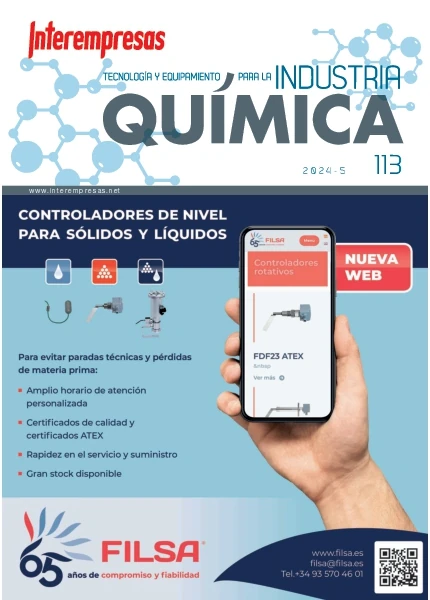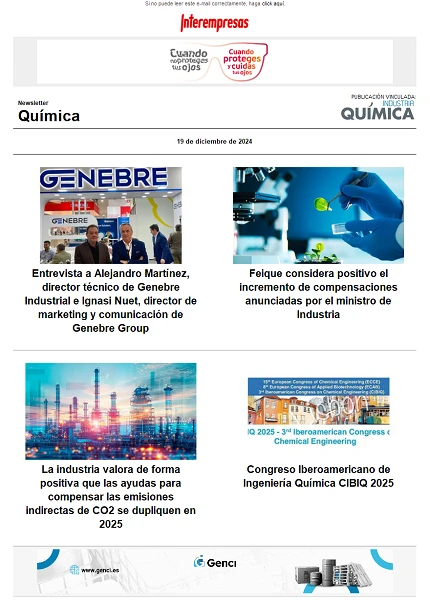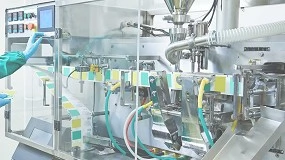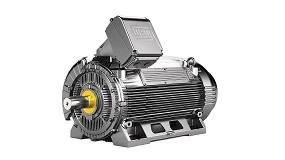Tecnología de envasado: versatilidad y alto potencial de innovación
9 de junio de 2009
Los envases son un producto extremadamente versátil que puede modificarse con gran rapidez para ajustarse a los cambios en los gustos de los consumidores. En este sentido, hay que tener en cuenta que las zonas de cooperación económica no paran de aumentar y que, con ello, las barreras comerciales se están eliminando. Este proceso facilita el acceso a nuevos mercados y grupos de consumidores, y fomenta la demanda de nuevos tipos de envases. Además, el papel de los envases como instrumento de comunicación y vehículo para la proyección de la imagen de marca está cobrando cada vez más importancia. Hace años nadie hubiera imaginado en el sobrio mundo de las farmacéuticas que sus productos iban a venderse en llamativos envases de colores plateados. Pero los tiempos han cambiado y la competencia se ha intensificado mucho en el mercado de mostrador (OTC). Sin duda, el sector del envasado no puede decir que no tenga ante sí retos y oportunidades. Los fabricantes de envases y diseñadores de maquinaria de envasado no dejan de idear soluciones innovadoras y muy eficaces, y el mercado les recompensa por ello.
A pesar de la incertidumbre reinante en la economía mundial, las perspectivas para el sector del envasado siguen siendo alentadoras. De acuerdo con las cifras publicadas por la VDMA (Federación Alemana de Ingenieros), en el año 2007 se fabricaron máquinas envasadoras por un valor de 21.800 millones de euros en todo el mundo. Alemania fue el productor líder con un 22,8% de cuota de mercado, seguida de Italia (16,5%), Estados Unidos (10,9%) y Japón (10,1%). De acuerdo con los datos aportados por la Asociación de Maquinaria de Envasado y Alimentación VDMA, en el año 2008 las ventas de máquinas de envasado alemanas registraron un crecimiento superior al 5%. Además, a la vista de la cartera de pedidos, el sector no ve razón para revisar las previsiones de negocio de 2009. De acuerdo con el volumen de órdenes de pedido recibidas en los últimos meses y si la tendencia actual continua hasta mediados de año, deberían registrarse unos niveles tan altos como los del año anterior. No obstante, la asociación sí admite que, dada la incertidumbre del mercado, podrían aplazarse las inversiones y, con ello, producirse algunos ajustes.
La asociación comercial estadounidense PMMI (Instituto de Fabricantes de Maquinaria de Envasado) seguía mostrándose optimista en septiembre de 2008: según informó, los envíos estadounidenses de máquinas de envasado habían registrado un crecimiento del 3,9%. El valor de los envíos de máquinas de envasado había aumentado hasta 6.200 millones de dólares estadounidenses y las exportaciones se habían incrementado un 17,8%. Los segmentos más importantes en Estados Unidos fueron: alimentación (37,9%), bebidas (22,3%) y productos farmacéuticos (9,9%).
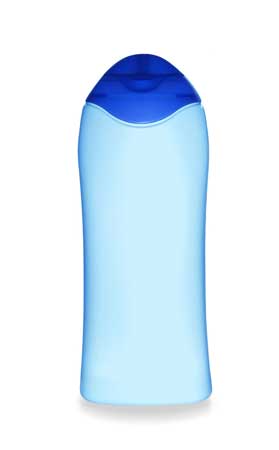
Innovación, sinónimo de éxito
Conseguir unos resultados excelentes no es cuestión de suerte. El sector del envasado siempre está al día con los últimos avances y no para de ofrecer soluciones nuevas e inteligentes en respuesta a los cambios sociales. La demanda de unidades de envasado más pequeñas, la necesidad de adaptarse a las preferencias cada vez más específicas de los usuarios y la continua evolución de los diseños de los envases plantean grandes retos a los fabricantes de máquinas envasadoras. Para poder enfrentarse al aumento de la demanda de formatos especiales, el fabricante tiene que ofrecer máquinas envasadoras muy flexibles. Y para producir tipos especiales de envase en grandes cantidades, el sector tiene que diseñar máquinas y sistemas de envasado versátiles, con capacidad para manejar distintos tipos y tamaños de envase en una misma línea.
Los fabricantes deben poder ajustar sus máquinas con facilidad, de modo que puedan reaccionar rápidamente a los cambios en las tendencias del mercado y en las demandas de los consumidores, y por ello, últimamente imperan las soluciones completas de sistemas (incluidas planificación y puesta en marcha) y el diseño modular. Uno de los objetivos fundamentales del proceso de creación de productos es aumentar la velocidad de procesamiento mediante microelectrónica y tecnología de procesadores. Así, mientras que hace veinte años el 80% del presupuesto para desarrollo se asignaba a ingeniería mecánica y el software sólo se llevaba el 5%, ahora el software y la ingeniería mecánica representan cada uno en torno a un 40% del gasto en desarrollo.
La robótica es, muchas veces, la mejor manera de conseguir la versatilidad necesaria para trabajar con la amplia variedad existente de productos. Los equipos robóticos son fundamentales en las operaciones de envasado y manipulación de los envases. De hecho, como prueba de la importancia de la robótica en el sector del envasado, basta con señalar que el sector de las máquinas envasadoras es el segundo mercado más importante para los fabricantes de sistemas robóticos. Sólo el sector de la automoción adquiere más sistemas de este tipo. Otra característica cada vez más común en la tecnología de envasado es la inteligencia distribuida. Las altas prestaciones que ofrecen las máquinas envasadoras actuales son posibles gracias al uso de sensores, cámaras y software de procesamiento de imágenes, elementos que se han convertido en equipamiento estándar.
A pesar del predominio de soluciones de sistemas completos y del diseño modular, muchos detalles todavía deben fijarse entre el fabricante y el cliente, para llegar en cada caso a la solución más económica y mejor desde el punto de vista de la higiene y la estética. Los envases «fáciles» son un buen ejemplo. Los cambios demográficos están marcando la dirección de los mercados en muchos países industrializados. Así, por ejemplo, debido al incremento de consumidores mayores, cada vez es más importante ofrecer envases fáciles de utilizar: desde envases fáciles de abrir y envases resellables hasta envases unidosis. Otro cambio demográfico que afecta al mercado es el aumento de los hogares unipersonales (por ejemplo, en la aparición envases pequeños de una ración).
Otro elemento importante al que deben prestar atención los fabricantes de envases es la necesidad de adaptar el envase a la forma de llenado. Las botellas de PET sin revestimiento, por ejemplo, no ofrecen una barrera suficiente contra los gases: existe el peligro, por un lado, de que se produzcan fugas de dióxido de carbono de la bebida que está dentro de la botella y, por otro, de que en la botella penetre oxígeno (con la consiguiente merma de la vida de almacenamiento del producto). El envase debe, asimismo, proteger los productos frente a la luz ultravioleta, que puede tener efectos negativos sobre el color, el sabor y el valor nutritivo de los alimentos.
La creciente variedad de productos hace que éstos cambien con más frecuencia y que el tamaño de los lotes sea cada vez más pequeño. Para poder diseñar máquinas y sistemas muy flexibles, que puedan servir en todas estas aplicaciones, son necesarias soluciones de alta tecnología. La demanda de unidades de envasado más pequeñas para alimentos supone un mayor consumo de material y también unos mayores costes de llenado.

Giro radical
Hasta la explosión de la crisis financiera, la única nube en el horizonte del sector era el aumento continuado de los costes del material, de la energía y del transporte. Los efectos se hicieron notar, sobre todo, en el mercado de los materiales de envasado, aunque las condiciones siguieron siendo satisfactorias por lo menos hasta abril de 2008. De acuerdo con el Comité de Fabricantes Alemanes de Envases (GADV), en el año 2008, se fabricaron en torno a 18,5 millones de toneladas de envases, con un aumento interanual de los volúmenes de producción del 5%. El valor de los bienes producidos ascendió a 30.300 millones de euros, es decir, cerca de un 10% más que en 2006.
No obstante, los resultados varían de un tipo de material a otro. El valor de los envases de papel, cartón, cartulina y metal (aluminio y acero) fue el que más subió (+11%). El valor de los envases de plástico también aumentó significativamente (+9%) y el de los envases de vidrio lo hizo un 6,8%.
El volumen de producción de los envases de papel y cartón también fue impresionante: en concreto, en 2007, se fabricaron 8,7 millones de toneladas de envases de estos materiales (+6%). El segundo tipo de envase más fabricado fueron los de vidrio con 4,1 millones de toneladas (+4,1%), seguidos de cerca por los de plástico, con 4 millones de toneladas (+5%). La producción de envases de metal, por su parte, se incrementó en 2007 un 4,7%, hasta 1,7 millones de toneladas.
Aumento continuado de los contenedores de granel
El mercado de los contenedores para transporte de sustancias químicas se reparte casi a partes iguales entre los contenedores a granel (IBC) y los barriles de acero y PE (30% cada uno), aunque parece que la balanza se está inclinando hacia los IBC. Se calcula que el número de unidades sólo en el mercado europeo se sitúa entre 4,5 y 5 millones. Los IBC ofrecen ciertas ventajas obvias: óptimo aprovechamiento del espacio (el volumen equivale a cinco barriles), gran flexibilidad, fácil manipulación y mínimo impacto medioambiental gracias a unos sistemas de retorno innovadores. Éstas son algunas de las razones por las que los contenedores de granel han ido ocupando el hueco existente entre los barriles y las cisternas a lo largo de más de 30 años.
Los fabricantes deberían tener siempre en cuenta el equilibrio energético de sus productos. Por ejemplo, los IBC de plástico son mucho más ligeros que los IBC de acero y, por tanto, el consumo de energía para el transporte es menor. Es lo mismo que ocurre con las botellas de PET retornables en comparación con las botellas de vidrio: las botellas de PET son más ecológicas ya que su peso es un doceavo del de una botella de vidrio.
Existe una amplia variedad de IBC; además, estos contenedores pueden utilizarse para el almacenamiento y transporte tanto de productos líquidos como pastosos (incluidas mercancías peligrosas). El ámbito de aplicación de estos contenedores es, además, enorme y va desde el sector de las pinturas hasta el sector de la alimentación. Entre todos, el sector químico ha sido siempre uno de los principales consumidores de IBC, aunque los fabricantes de estos contenedores señalan que hay muchas aplicaciones potenciales en el sector petroquímico.
Los agentes de mercado calculan que el sector europeo de los IBC se va a ampliar en torno a un 8% anual en los próximos dos años. Después, según las previsiones, el crecimiento de este mercado en Europa se estancará. Estas optimistas previsiones se fundamentan, en parte, en la creatividad en cuanto diseños (enrejados más resistentes, contenedores transparentes que permiten ver el contenido y nuevas características de protección contra explosiones).
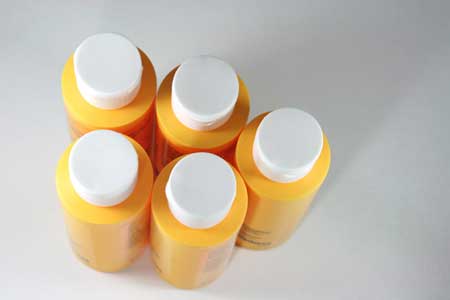
Etiquetas, fuente de información
La identificación del producto requiere cada vez más espacio para dar cabida a múltiples idiomas y cumplir los requisitos legales, que pueden variar de un mercado a otro. En una etiqueta se puede imprimir prácticamente cualquier tipo de información, sin olvidar que las etiquetas permiten, además, el rastreo de los lotes. El reto de los ingenieros es condensar toda esta información en el espacio más pequeño posible mediante códigos EAN (número europeo de artículo), códigos de matriz de datos o RFID (identificación por radiofrecuencia).
En cuanto a la RFID, sus beneficios todavía están en tela de juicio. Así, mientras que algunos agentes logísticos creen esta tecnología presenta un gran potencial y puede ayudar a optimizar la gestión de inventarios, otros siguen siendo escépticos y creen que los sistemas de identificación existentes todavía ofrecen importantes oportunidades que no han sido explotadas. En todo caso, el mundo del etiquetado ofrece muchas otras ideas innovadoras, por ejemplo, etiquetas inteligentes que incorporan indicadores de hora y temperatura: estas etiquetas registran exactamente cómo han sido almacenadas las unidades de envasado e interesan principalmente al sector de la alimentación y al sector farmacéutico.
Independientemente del formato de la información, lo que es cierto es que la cantidad de información incluida en los productos no para de aumentar. Así, el reto está en introducir una gran cantidad de datos en el espacio más pequeño posible, pero al mismo tiempo utilizar una letra que, por muy pequeña que sea, sea legible. Todo esto sin olvidar que los envases, sobre todo en productos farmacéuticos y químicos, deben ser extremadamente resistentes a los arañazos y a la fricción para garantizar su rastreabilidad. Así, a pesar del alto grado de sofisticación, lo más importante es que las etiquetas queden bien fijadas en cartones, contenedores y envases muy pequeños, por ejemplo ampollas de vidrio, con un coste mínimo.
Envases, aliados en la lucha contra las falsificaciones
La Comisión Europea calcula que las pérdidas provocadas por la falsificación de productos ascienden a unos 500.000 millones de euros en todo el mundo, una cifra que equivale a entre un 7% y un 10% del comercio internacional. Y la pérdida de cifra de negocio no es el único problema. Las falsificaciones entrañan otros riesgos como son el daño a la imagen corporativa y, en el peor de los casos, litigios judiciales. Las falsificaciones de mala calidad pueden provocar daños irreparables en el prestigio de una marca, ya que el consumidor no adquiere la calidad que espera del producto.
Además de las pérdidas de ingresos para la empresa, estas prácticas ilegales ponen en peligro miles de puestos de trabajo muy atractivos y con altas remuneraciones en todo el mundo; en concreto, se calcula que en Europa serían unos 200.000 puestos de trabajo.
Las falsificaciones de productos también suponen un riesgo para la salud de los consumidores. Los expertos estiman que en torno a un 10% de los productos farmacéuticos son falsificaciones. Además, esta práctica ya no se restringe únicamente a productos de alta gama y al sector de bienes de lujo; el problema se está propagando, y con gran rapidez, a bienes relativamente baratos de consumo masivo. Una de las razones de este incremento es que los falsificadores han aumentado el grado de profesionalidad y cada vez hacen copias mejores y con más facilidad.
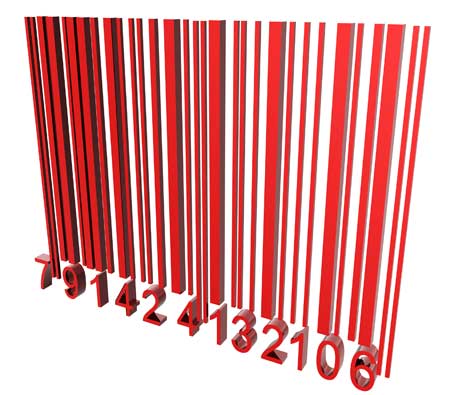
Los envases son un arma fundamental en la batalla contra la falsificación de productos. Cuantas más propiedades de seguridad incluya un producto, más fácil será que el falsificador pase por alto alguna o que no pueda copiarlo. Por ejemplo, los envases pueden estar sellados para ofrecer protección contra intervenciones. Cuando el envase se abre por primera vez, aparece un logotipo o alguna frase y el proceso no puede ‘rebobinarse’ (efecto de invalidación). También existen técnicas para incorporar marcas de identificación ‘ocultas’: microtextos y nanotextos, marcas de color verdadero y marcas de seguridad ocultas legibles por láser.
Para los consumidores, es importante que el envase incorpore marcas visibles, por ejemplo, hologramas, que le permitan identificar si el producto es original sin necesidad de utilizar lectores o lámparas ultravioleta. Los falsificadores se concentran en las características visibles y, por esta razón, se utilizan características de seguridad invisibles en productos sensibles.
No obstante, las propiedades de seguridad del envase no ofrecen, por sí solas, una protección suficiente, ya que los falsificadores pueden detectarlas y copiarlas o, al menos, imitarlas. Es más efectivo utilizar estrategias de seguridad que cubran toda la cadena logística. Estas estrategias exigen aplicar enfoque holístico en lo que se refiere a la gestión y asesoría sobre el envase, una estrategia que cubra todo el proceso, desde el diseño conceptual y el desarrollo, pasando por la transmisión de datos, la producción y el uso de la unidad envasadora, hasta la entrega al cliente final. Los códigos de seguridad dan al envase una identidad única y permiten llevar un control en línea de los productos. Los minoristas y usuarios saben inmediatamente y con seguridad si el producto es original o una falsificación.
Bayer Technology Services e Ingenia Technology Ltd lanzaron en 2007 un nuevo método de protección contra falsificaciones que ha captado bastante atención. Esta técnica no se basa en la incorporación de marcas visibles u ocultas en el producto sino que utiliza la tecnología denominada «autenticación de superficies mediante láser» (LSA). Esta técnica consiste en la exploración y el registro de las características naturales que presenta la superficie de un producto y en la creación, a partir de estos datos, de una huella única.
Mediante un método de escaneado especial basado en el fenómeno del moteado láser, se analiza la estructura microscópica de la superficie del producto. La dispersión difusa de la superficie se mide desde distintos ángulos en relación con el ángulo de incidencia del haz. Las propiedades de la superficie así detectadas por el escáner son únicas del producto; es decir, son como una huella dactilar o una secuencia de ADN. Además, esta huella no se ve alterada por un desgaste o cambios moderados en el producto.
La probabilidad de que dos objetos tengan la misma huella es de entre 10-20 y10-100. La señal registrada por el escáner contiene información única del objeto. Además, la estructura de la superficie es tan compleja que es imposible reproducirla artificialmente. Toda la información recogida por el escáner puede almacenarse en una base de datos y recuperarse en cuestión de segundos mediante un software de búsqueda y comparación. La cantidad de equipos de TI instalados puede adaptarse fácilmente al número de productos y a las distintas ubicaciones. Tan sólo se necesitan 125-750 bytes para guardar un escaneado y un disco duro convencional es suficiente para almacenar los datos de millones de productos.
Las innovaciones son siempre muy bien recibidas, pero los usuarios finales no suelen estar dispuestos a pagar por ellas. Así, puesto que los márgenes con los que operan ciertas industrias clave, como los bienes de consumo, son muy pequeños, los ingenieros del sector del envasado trabajan, a su vez, en un entorno donde la presión económica es muy fuerte. La creatividad, el conocimiento exhaustivo de los materiales y la cooperación entre los productores de los materiales de envasado, los fabricantes de máquinas envasadoras y los clientes constituyen la única vía para crear soluciones de envasado innovadoras.



